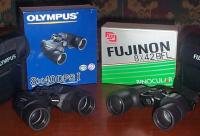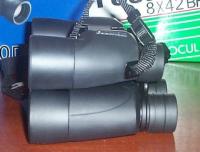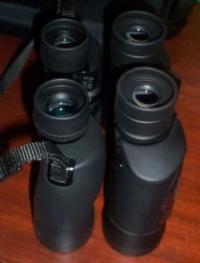ICEINSPACE
|
Moon Phase
CURRENT MOON
Waxing Crescent 16.7%
|

|
 |
Olympus 8x40 DPS I vs Fujinon 8x42 BFL
Submitted: Wednesday, 14th September 2005 by Steve H (janoskiss)
Update: Steve has supplied an update (10th Feb) to this review - please see the bottom of the review.
I have recently become the proud owner of a pair of Fujinon 8x42 BFL binoculars. I also bought a less expensive pair of Olympus 8x40 DPS I as a present for someone who wanted something light, but better than the cheaper compact roof prism binoculars, to take to the beach for the occasional look at seals, dolphins, birds and so on.
I had two 10-15 minute sessions, one during daylight hours and another at night under light polluted skies, comparing the two binoculars. This document is a summary of my impressions after these short viewings. Please note that I have little to no experience with quality optics and I am very much a newbie amateur astronomer, having owned my first telescope for the past 9 months.
 |

Click to Enlarge
The contenders: Olympus 8x40 DPS I on the left and the Fujinon 8x42 BFL on the right
 |
 |
Fujinon 8x42 BFLMade in Japan. Price: $340 -- I got mine for $300 from York Optical in Melbourne but I really was not prepared to spend more. It is probably still a good buy at $340, but to be honest I don't really know. This was my first step into big-buck bino land.
The Likes (in no particular order)
- Incredibly small, light and the smooth rubber exterior is very comfortable; has to be experienced to be believed; they are tiny and weigh next to nothing, and fit like a glove.
- Stars are very bright for the size of the binoculars.
- Colour neutral coatings give "true" colour.
- No visible chromatic aberration on bright celestial objects (Moon, Venus, Jupiter, bright stars).
- Great contrast with practically no ghosting on bright targets like the Moon (a few times I caught a glimpse of a dim reflection, but when I tried to find it again I could not).
- Large planets like Jupiter and Venus are disks and stars are sharp with no flaring (except for the diffraction from the slight intrusions at the edges of the optical pathway, see below).
- Mechanically flawless: everything is very smooth and steady: focus, interpupillary distance and diopter adjustment; and despite the binos being a featherweight, every component is very solid and stays put.
The Dislikes (in order of most to least important)
- Some diffraction spikes visible on brightest stars and planets. This is most likely because the prisms are only just big enough and ever so slightly intrude at the very edge of the circular cross-section of the optical path. You can see this looking down the barrels through the objective lens.
- Relatively narrow apparent field of view of 52 degrees makes
- finding things in the night sky a bit more difficult than with wide view (65-degree) binoculars,
- nature watching and stargazing less immersing (although the superior brightness and contrast more than makes up for it in the latter case).
- Slight but easily visible chromatic aberration (green & violet) at the edges of dark objects (branches) in front of bright background (sky).
- All the lens caps are just a little too big. They fall off easily and it is near impossible to get the binoculars out of their pouch without at least one of the objective lens caps coming off. (I have the same problem with my TeleVue Plössl! Is this a general expensive optics thing??)
 |
 |  |  |

Click to Enlarge
The Fujinon BFL is smaller and lighter than the Olympus DPS I, which makes it a lot more comfortable for hand-held use.
 |
 | 
Click to Enlarge
Side by side
 |
Olympus 8x40 DPS IMade in China. Price $102 = $90 + $12 postage from centre.net.au.
The Likes (roughly in order of most to least important)
- Wide field of view (65 degree AFOV, 8.2 TFOV) really puts you inside the view during daytime, or lets you navigate unfamiliar heavenly delights with more ease at night. I was quicker to find particular stars and DSOs with these than with the Fujinon. The wide views of the sky are also impressive. M6 & M7 fit in the FOV with ample room to spare. With the Fujinon they just squeeze in. The blurry outer edge does not matter that much, because unlike with wide angle eyepieces in a telescope, my peripheral vision does not seem to care when it comes to binoculars.
- Price!
- Excellent "nature watching" views! It seemed to be brighter and have better contrast than the Fujinon! Eventually I realised that my brain has been fooled by the lens coatings, which give a greenish tint to the view, making the colours of all things green (leaves of trees, grass, bush) more vivid, and giving the impression of enhanced brightness and contrast. It works really well and looks very impressive but comes at a price (see below).
- Stars focus fairly sharply and show no obvious flaring. It is not as sharp as the BFL, but direct comparison is complicated by the reduced brightness of the DPS I.
- One can easily see the brighter DSOs like M22, M17, M8, M20 under light polluted skies (20km from CBD).
- Lens caps are a good fit and stay put.
The Dislikes (in order of most to least important)
- Internal reflections are apparent and very distracting when viewing the just three day old Moon. A number of ghost images can be seen in the FOV. (The ghosts from the left and right oculars do not merge.) Not apparent during the day or even with brighter stars at night.
- Excessive movement of right eyepiece with diopter adjustment when pressing down on eyecup (due to use of plastic components).
- Bright stars do not appear as bright as they do with the Fujinon and faint stars are a harder to spot. This is not a huge difference, but the longer you look at large clusters and groups of fainter stars the more obvious it is. I suspect at a dark site the differences would be even more apparent.
- The greenish tint in the lens coatings that give the psycho-optic colour and contrast enhancement to all things green distract from the natural colour of other targets. Looking at a brick wall, or a rusty drum hanging on a light pink painted wall, the colours were a bit off, like looking through green coloured sunnies (but a bit more subtle). At night you cannot tell though, and colours of brigher stars come through fairly well, although not quite as vividly as in the Fujinon.
- Ergonomics is not the best. Exterior does not feel all that nice to the touch. It's molded plastic with a bit of rubber mixed in and has a coarse finish. Rims of eyecups have a slightly sharp edges (where two halves of a mold join). It is also much bulkier than the Fujinon (bigger prisms for the wide angle design).
- Venus seemed less well defined than with the Fujinon, but it was hard to get a good look because of all the ghosting from the Moon right next to it. Unfortunately I did not get to look at Jupiter with this pair.
- Chromatic aberrations are similar to the Fujinon's, so one can't really complain.
ConclusionsThe Fujinon is a very good performer for its small size and I cannot imagine a more comfortable pair of binoculars for hand-held use. Its superior brightness, sharpness and contrast is most apparent when viewing the night sky.
For about a third of the cost, the Olympus does a surprisingly good job, and the wider field of view is very pleasant, as well as useful for star hopping. Strong glare and ghosting on the Moon (and presumably other bright objects at night) is its main weakness. Update 10th Feb 2006I had plenty of time now to try out the Fujinon 8x42 BFL binoculars under different conditions, hand-held and tripod mounted, at night and in daylight.
For astronomy, they are very nice for scanning the night sky and as a star hopping aid or finder. Mounted on a tripod, they clearly show phases of Venus and the Moon looks great with no false colour. The coatings on the optics are superb for astronomy and give terrific contrast with a dark sky background, even on the brightest stars planets and the Moon. However, on rich star fields, they do show some astigmatism near the edge of the field. These aberrations normally go unnoticed in daylight and largely also at night unless a tripod is used (or perhaps in steadier hands than mine).
I have taken the BFLs bushwalking a number of times, and I found them to be just superb at what they are sold for: bird- and nature-watching. The focuser is so smooth that you can easily follow birds in flight and keep the image in focus. Range of focus is very good, and you can focus on things 2-3 metres away. The images are so sharp that you tend to forget you are looking through optics and you really feel like you have been transported into the scene.
Question I feel I should answer is: Are these the ideal hand-held (finder/star-hopper) binoculars for astronomy for the price? I honestly don't know, but probably not. Considering that the field of view of the Fujinon BFL binoculars is relatively narrow (about 50 degrees), I would like better off-axis performance. I feel that for astronomy the poor edge performance is the biggest shortcoming of BFL 8x42s. On the other hand, this is not much of an issue for hand-held use, and the coatings on the optics are superb and give terrific contrast with a dark sky background, even on the brightest stars, planets and the Moon.
Review by Steve H (janoskiss). Discuss this review on the IceInSpace Forums.
|
 |
|